 |
| The first museum of Delphi was built in 1903 on the plans of the French architect Tournaire and was later incorporated in a larger edifice, constructed in 1938. The rearrangement of the exhibition was carried out gradually and was finally completed in 1980. In 1974, a new room was added for the exhibition of the gold and ivory finds from the sanctuary. |
|
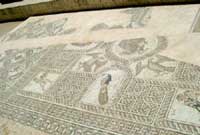 |
|
| A project for the further enlargement of the museum, which has improved the display of the finds as well as the appearance of the building, has already been made by the Ministry of Culture. The museum is actually an integral part of the sanctuary and contains exclusively finds from the site of Delphi, mostly offerings and architectural parts. Some of the most important exhibits are: |
|
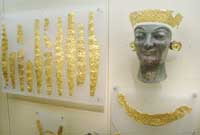 |
|
Cleobis and Biton:Archaic statues representing two brothers from Argos, Cleobis and Biton or, according to a second interpretation, the Dioskouroi. They are the work of the Argive sculptor (Poly)medes. Dated between 610 and 580 B.C.
Chryselephantine statues: Two life-size heads made of ivory and gold, from the chryselephantine statues of gods, interpreted as Apollo and Artemis. |
|
| The frieze from the Treasury of the Siphnians: decorated with relief representations of mythological scenes. On the north side, which is the finest and best preserved, there is a representation of Gigantomachy, the war of the gods of Olympus against the Giants. It is a wonderful specimen of the mature Archaic art, dated to 525 B.C. |
|
| Metopes from the Treasury of the Athenians: Marble metopes from the facade of the Treasury, with representation of Amazonomachy, the Labors of Herakles and the Exploits of Theseus. They were undoubtedly the work of skilled Athenian sculptors and date to ca. 490 B.C. |
|
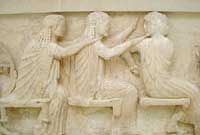 |
|
| White-ground kylix: decorated with a unique representation of Apollo. The god is seated on a stool, holds his lyre in his left hand and with his right pours the libation from a bowl. It is the work of an unknown skilled painter, dated to 480-470 B.C.
The Charioteer: Bronze statue of a charioteer, originally belonging to a larger group which represented a chariot drawn by four horses. It was dedicated to Apollo by Polyzalos, the tyrant of Gela, in 478 B.C. when he won the chariot-race at the Pythian Games. This incomparable statue is a representative example of the ''severe'' Attic style, certainly the work of a major artist. |
|
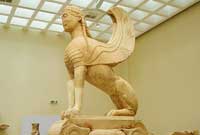 |
|
Marble statue of Aghias: an athlete of the pankration (a kind of wrestling), famous for his victories in the 5th century B.C. It is a copy of a bronze original which was made by Lysippos and belongs to the group of statues offered to Apollo by the Thessalian Daochos II, the hieromnemon (representative) of Thessaly in the Amphictyonic League of Delphi. |
|
| Bronze incense-burner: A wonderful vessel in the shape of a young woman wearing a peplos ("peplophoros"). In her upraised hands she holds a hemispherical cauldron in which the incense was placed. It is an original work of a skilled artist, dated to ca. 460-450 B.C. |
|
| The "Column of the Dancers": Statues of three young women forming the upper part of a column encircled with acanthus leaves. The figures are dancing, all wear a short, transparent chiton and bear a basket-like polos on their heads. They supported a bronze tripod cauldron. The column is an Athenian offering to the sanctuary, dated to ca. 330 B.C. |
|
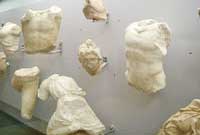 |
|
| Statue of Antinoos: Marble statue of Antinoos, a youth famous for his beauty, and the favorite of emperor Hadrian. This is one of the best "cult" statues of the young man, who is portrayed as a god. It is a typical example of the "Renaissance" style of the 2nd century A.D. |
|
|
 |
|
|
|
